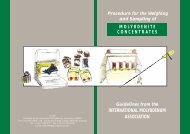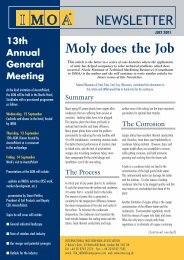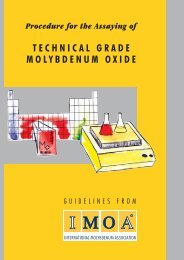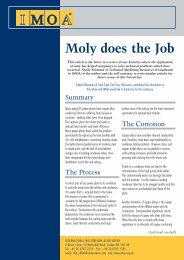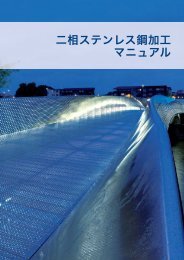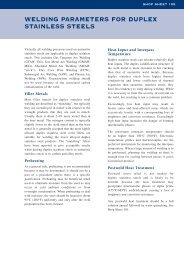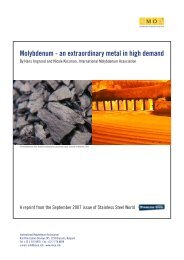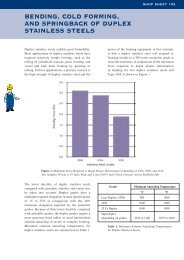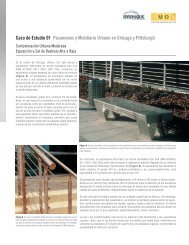The Evolution of High Performance Stainless Steel - IMOA
The Evolution of High Performance Stainless Steel - IMOA
The Evolution of High Performance Stainless Steel - IMOA
You also want an ePaper? Increase the reach of your titles
YUMPU automatically turns print PDFs into web optimized ePapers that Google loves.
THE EVOLUTION OF<br />
HIGH PERFORMANCE<br />
STAINLESS STEELS<br />
WRITTEN FOR <strong>IMOA</strong> BY DR. J. REDMOND AND<br />
DR. R. DAVISON OF TECHNICAL MARKETING RESOURCES<br />
PUBLISHED BY THE INTERNATIONAL MOLYBDENUM ASSOCIATION<br />
I<br />
M O<br />
A<br />
© INTERNATIONAL MOLYBDENUM ASSOCIATION
UNS Proposed Alloy Name Cr Ni Mo Cu N Other<br />
Number EN 10027<br />
Number<br />
Standard Austenitic <strong>Stainless</strong> <strong>Steel</strong>s<br />
S30403 1.4307 Type 304L 18 8 – – – –<br />
S31603 1.4404 Type 316L 16 11 2 – – –<br />
N08020 – Alloy 20 20 34 2.2 3.5 – Cb<br />
S31703 1.4438 Type 317L 18 12 3 – – –<br />
<strong>High</strong> <strong>Performance</strong> Austenitic <strong>Stainless</strong> <strong>Steel</strong>s<br />
– – Alloy 24 24 17 4 – 0.40 6 Mn<br />
S31725 – 317LM 18 13 4.3 – – –<br />
S31726 1.4439 317LMN 17 14 4.25 – 0.15 –<br />
N08904 1.4539 904L 20 25 4.5 1.5 – –<br />
S34565 – 4565 S 24 17 4.5 – 0.50 6 Mn<br />
N08932 1.4537 UR SB8 (1) 25 25 5 1.5 0.20 –<br />
S31254 1.4547 254 SMO (2) 20 18 6 0.75 0.20 –<br />
N08367 – AL-6XN (3) 20 24 6 – 0.20 –<br />
N08926 1.4529 1925hMo (4) / 25-6MO (5) 20 25 6 1 0.20 –<br />
– – Polarit 778 (6) 20 22 6 0.75 0.20 –<br />
N08026 – 20Mo-6 (7) 23 34 6 3 0.12 –<br />
N08031 – Alloy 31 27 31 6 1.2 0.20 –<br />
S32654 – 654 SMO (2) 24 22 7.3 0.50 0.50 3 Mn<br />
Second Generation Duplex <strong>Stainless</strong> <strong>Steel</strong>s<br />
S32304 1.4362 2304 23 4 – – 0.10 –<br />
S32950 1.4460 7-Mo PLUS (7) 26.5 4.8 1.5 – 0.20 –<br />
S31803 1.4462 2205 22 5 3 – 0.02 –<br />
S32550 1.4507 Ferralium 255 (8) 25 6 3 2 0.20 –<br />
S31260 – DP-3 (9) 25 7 3 0.5 0.15 0.3 W<br />
S37260 1.4501 Zeron 100 (10) 25 7 3.6 0.75 0.25 0.75 W<br />
– 1.4507 UR52N+ (1) 25 6 3.8 1.5 0.25 –<br />
S32750 1.4410 2507 25 7 4 – 0.25 –<br />
<strong>High</strong> <strong>Performance</strong> Ferritic <strong>Stainless</strong> <strong>Steel</strong>s<br />
S44400 1.4521 Type 444 (18Cr-2Mo) 18 – 2 – – Ti, Nb<br />
S44627 – E-BRITE 26-1 (3) 26 – 1 – – Nb<br />
– – 29Cr-3Mo (11) 29 – 3 – – 0.4 Ti<br />
S44660 – SEA-CURE (12) 27.5 2 3.5 – – 0.4 Ti<br />
S44735 1.4592 AL 29-4C (3) / 290 Mo (11) 29 – 4 – – 0.4 Ti<br />
(1) Trademark <strong>of</strong> Creusot-Loire Industrie (7) Trademark <strong>of</strong> Carpenter Technology Corp.<br />
(2) Trademark <strong>of</strong> Avesta Sheffield AB (8) Trademark <strong>of</strong> Langley Alloys Ltd.<br />
(3) Trademark <strong>of</strong> Allegheny Ludlum Corp. (9) Trademark <strong>of</strong> Sumitomo Metals<br />
(4) Trademark <strong>of</strong> Krupp-VDM (10) Trademark <strong>of</strong> Weir Materials Ltd.<br />
(5) Trademark <strong>of</strong> the INCO family <strong>of</strong> companies (11) Trademark <strong>of</strong> Vallourec<br />
(6) Trademark <strong>of</strong> Outokumpu Oy (12) Trademark <strong>of</strong> Crucible Materials Corp.<br />
2<br />
TABLE 1.<br />
NOMINAL COMPOSITIONS (WT. PCT.)
STAINLESS STEEL 93<br />
In the most recent years, there has been an annual<br />
international conference on stainless steels. Innovation<br />
<strong>Stainless</strong> <strong>Steel</strong>, the <strong>Stainless</strong> <strong>Steel</strong> 93 conference, was<br />
held in Florence, Italy, October 11-14, 1993. As<br />
suggested by its title, it focused on both the results <strong>of</strong><br />
innovations in the stainless steel industry and on the<br />
process <strong>of</strong> innovation itself. <strong>The</strong> Conference was<br />
sponsored by the Associazione Italiana de Metallurgia,<br />
under the auspices <strong>of</strong> the Commission <strong>of</strong> the European<br />
Communities and the Nickel Development Institute. It<br />
would be difficult to imagine a place <strong>of</strong> richer cultural<br />
heritage or a more hospitable host. For those who could<br />
not attend, we must say that you missed a wonderful<br />
personal experience. We cannot hope to adequately<br />
describe the delight <strong>of</strong> Florence, but we will <strong>of</strong>fer here a<br />
brief review <strong>of</strong> some <strong>of</strong> the technical discussions.<br />
<strong>IMOA</strong> was pleased to sponsor a paper (1). Written by<br />
Davison and Redmond, both formerly with the Climax<br />
Molybdenum Company in the United States, it<br />
examined the processes <strong>of</strong> innovation and evolution that<br />
have brought so many new grades <strong>of</strong> stainless steel to<br />
commercial significance in the twenty-five years since<br />
the introduction <strong>of</strong> argon oxygen decarburization<br />
(AOD) refining. This paper, <strong>The</strong> <strong>Evolution</strong> <strong>of</strong> <strong>High</strong><br />
<strong>Performance</strong> <strong>Stainless</strong> <strong>Steel</strong>s, is reprinted in this<br />
brochure.<br />
For this summary we have chosen to focus on just four<br />
major themes <strong>of</strong> the Conference:<br />
1. Role <strong>of</strong> nitrogen in austenitic stainless steels;<br />
2. Maturing <strong>of</strong> the second generation <strong>of</strong> duplex<br />
stainless steels;<br />
3. Role <strong>of</strong> stainless steel in everyday life; and<br />
4. Public education on stainless steel.<br />
ROLE OF NITROGEN<br />
One feature <strong>of</strong> the AOD and similar refining vessels that<br />
was not fully appreciated in the first decade <strong>of</strong><br />
application was the ease <strong>of</strong> introduction and precise<br />
control <strong>of</strong> nitrogen as an alloy element in stainless steel.<br />
Initially considered only as an inexpensive austenitizer,<br />
nitrogen is now appreciated for its contributions to<br />
strength, corrosion resistance, and phase stability in<br />
austenitic stainless steel with high chromium and<br />
molybdenum. As in the past, the Swiss Federal Institute<br />
<strong>of</strong> Technology made excellent contributions, both in<br />
defining the potential for future developments and in<br />
facilitating practical applications <strong>of</strong> the high nitrogen<br />
materials. Speidel, always the enthusiastic advocate for<br />
the high nitrogen technology, discussed corrosion<br />
resistant tool steels <strong>of</strong> remarkable nitrogen content<br />
produced by powder metallurgy and by high pressure<br />
electroslag remelting (2). His associates at the Institute<br />
demonstrated the comprehensive approach being<br />
followed. Uggowitzer presented a theoretical d-shell<br />
electron theory justification for the effects <strong>of</strong> nitrogen<br />
(3). Rechsteiner showed how melting under high<br />
pressure nitrogen enables practical production <strong>of</strong><br />
austenitic stainless steels with up to 1.1% nitrogen (2).<br />
Paulus addressed the difficulties <strong>of</strong> processing these<br />
high strength materials on conventional equipment with<br />
an evaluation <strong>of</strong> warm processing techniques (4).<br />
Only a few years ago the idea <strong>of</strong> commercialization <strong>of</strong> a<br />
0.5% nitrogen austenitic stainless steel would have been<br />
thought radical, far in the future. But Wallén <strong>of</strong> Avesta<br />
Sheffield AB in Sweden reported on the new 654 SMO<br />
austenitic stainless steel with 24Cr-22Ni-7.3Mo-0.5N<br />
(5). Produced in conventional AOD and continuous<br />
cast in 70-ton commercial heats, this astonishing<br />
austenitic stainless steel has corrosion resistance<br />
approaching that <strong>of</strong> the nickel-base C alloys, together<br />
with substantially higher strength. (If we called the<br />
6Mo-0.2N austenitic stainless steels the “super<br />
austenitics”, what must we call this new grade?)<br />
With the high cost <strong>of</strong> alloy development, it is<br />
encouraging that the evolution <strong>of</strong> these new grades is<br />
not wholly empirical. <strong>The</strong>oretical studies <strong>of</strong> the<br />
thermodynamics <strong>of</strong> high nitrogen steels in advance <strong>of</strong><br />
the production trials have greatly shortened the time for<br />
development. For example, Foct <strong>of</strong> the Université de<br />
Lille in France discussed the thermodynamics <strong>of</strong> high<br />
nitrogen steels with the goal <strong>of</strong> reducing the practical<br />
limitations <strong>of</strong> production (6).<br />
In addition to the quantum leap to 0.5% N austenitic<br />
stainless steels, this is also the logical broadening to the<br />
range <strong>of</strong> products at the 0.2% N level. White, <strong>of</strong> Krupp<br />
VDM in Germany, reported on Nicr<strong>of</strong>er 3127, a high<br />
chromium 6% Mo grade with high nickel and copper,<br />
designed for high chloride acid streams, especially<br />
sulfuric and phosphoric acids (7).<br />
One focus <strong>of</strong> Innovation <strong>Stainless</strong> <strong>Steel</strong> was the<br />
recognition <strong>of</strong> the series <strong>of</strong> metallurgical and<br />
commercial barriers that must be overcome to move a<br />
research concept to practical application. One aspect <strong>of</strong><br />
this process is the need for a full range <strong>of</strong> welding<br />
practices to be developed for each new grade, including<br />
conventional high deposition rate welding, to assure that<br />
the new grade is economically competitive. Skirfors,<br />
speaking for the Royal Institute <strong>of</strong> Technology and<br />
3
Sandvik <strong>Steel</strong> AB <strong>of</strong> Sweden, reviewed the success<br />
achieved in welding the highly alloyed austenitic<br />
stainless steels by the submerged arc process,<br />
overcoming limitations <strong>of</strong> hot cracking that were<br />
previously assumed to apply to these grades with<br />
austenitic solidification (8). A remarkable range <strong>of</strong><br />
fillers, fluxes, and techniques have moved the super<br />
austenitics from special grades to standard materials <strong>of</strong><br />
construction.<br />
DUPLEX<br />
STAINLESS STEELS<br />
<strong>The</strong>re have been many conferences dedicated solely to<br />
duplex stainless steel technology. Innovation <strong>Stainless</strong><br />
<strong>Steel</strong> did not try to compete with the intensity and detail<br />
<strong>of</strong> those conferences, but the duplex stainless papers <strong>of</strong><br />
Florence do mark the progress <strong>of</strong> the duplex stainless<br />
development. In only one decade, the second generation<br />
<strong>of</strong> duplex stainless steels has become a complex family<br />
<strong>of</strong> great commercial significance and a comprehensive<br />
range <strong>of</strong> applications. Charles <strong>of</strong> Creusot-Loire<br />
Industrie <strong>of</strong> France gave an excellent survey <strong>of</strong> the<br />
evolution <strong>of</strong> the family <strong>of</strong> duplex grades (9). <strong>The</strong><br />
second generation is characterized by higher nitrogen<br />
contents, so it is no surprise that the duplex stainless<br />
steel development has proceeded simultaneously with<br />
that <strong>of</strong> the new austenitic grades.<br />
Gooch, speaking for <strong>The</strong> Welding Institute <strong>of</strong> the United<br />
Kingdom, showed the extent <strong>of</strong> their commercial<br />
acceptance <strong>of</strong> the duplex grades (10). It is clear that good<br />
welds can now be made by a range <strong>of</strong> welding processes.<br />
What is occurring now is the standardization <strong>of</strong><br />
procedures and qualifications, and the education <strong>of</strong> both<br />
fabricators and users, to permit the general use <strong>of</strong> the new<br />
and distinctive family <strong>of</strong> stainless steels.<br />
Several technically excellent papers demonstrated the<br />
quality <strong>of</strong> the increased understanding <strong>of</strong> duplex<br />
stainless steel welding and transformations. Nilsson,<br />
presenting a joint research effort <strong>of</strong> Sandvik <strong>Steel</strong> AB,<br />
Esab AB, and Avesta Sheffield AB <strong>of</strong> Sweden, showed<br />
the formation <strong>of</strong> secondary austenite in duplex welds,<br />
and with thermodynamic modeling and direct<br />
observations, explained the susceptibility <strong>of</strong> secondary<br />
austenite to pitting attack (11). Hertzman <strong>of</strong> the<br />
Swedish Institute for Metals Research showed that the<br />
various stainless steels conform to theoretical models for<br />
phase transformations, and that thereby the models are<br />
useful for predicting metal behavior (12).<br />
Detailed analyses <strong>of</strong> hot working behavior <strong>of</strong> 2304 and<br />
2205 stainless steels were provided by Barteri (13), <strong>of</strong><br />
Centro Sviluppo Materiali <strong>of</strong> Italy, and by Paúl (14), <strong>of</strong><br />
Acerinox <strong>of</strong> Spain. Even though duplex stainless steel<br />
was not an announced primary focus <strong>of</strong> Innovation<br />
<strong>Stainless</strong> <strong>Steel</strong>, it is indicative <strong>of</strong> the worldwide<br />
development <strong>of</strong> stainless steels that corrosion resistance,<br />
processing, welding, and applications <strong>of</strong> duplex grades<br />
were the subject <strong>of</strong> papers from Sweden, Korea,<br />
Belgium, France, Italy, Germany, Japan, Spain, Finland,<br />
and the United Kingdom.<br />
CONSUMER<br />
APPLICATIONS<br />
With all <strong>of</strong> the discussion <strong>of</strong> super austenitics and super<br />
duplexes, one might think that stainless steels are only for<br />
the most corrosive <strong>of</strong> applications; however, Innovation<br />
<strong>Stainless</strong> <strong>Steel</strong> also addressed the versatility <strong>of</strong> stainless<br />
steels in everyday life in food handling, automotive<br />
applications, architecture, and pollution control.<br />
<strong>Stainless</strong> steels have for years been the standard by<br />
which all other materials have been judged for hygienic<br />
applications. Remarkably, some questions have been<br />
raised in this area as all materials are being subjected to<br />
review. <strong>The</strong> industry must view this situation in a<br />
positive way, that although costly, these programs are an<br />
opportunity to demonstrate and quantify the superiority<br />
<strong>of</strong> stainless steels in these applications.<br />
Food applications, with a focus on the safety <strong>of</strong> stainless<br />
steel through non-interaction with the product and with<br />
ease <strong>of</strong> complete cleaning, were presented by Flint<br />
speaking for the Nickel Development Institute in the<br />
United Kingdom (15). Fischer (16), <strong>of</strong> Blanco GmbH <strong>of</strong><br />
Germany, and Tupholme (17), speaking for British <strong>Steel</strong><br />
Technical and Avesta Sheffield Ltd. <strong>of</strong> the United<br />
Kingdom, showed the thoroughness <strong>of</strong> this program to<br />
demonstrate the safety <strong>of</strong> stainless steels.<br />
Automotive applications <strong>of</strong> stainless steel have become<br />
a substantial commercial significance, not just for the<br />
catalytic converters to control exhaust emissions, but<br />
also for the whole exhaust systems to provide the<br />
economical reliability and durability demanded by the<br />
consumer. This application was covered by several<br />
speakers, including Rutherford (18), <strong>of</strong> Allegheny<br />
Ludlum Corporation <strong>of</strong> the United States, and by Pauly<br />
(19), <strong>of</strong> Informationsstelle Edelstahl Rostfrei <strong>of</strong><br />
Germany. <strong>The</strong> comments <strong>of</strong> these speakers on the role<br />
<strong>of</strong> stainless steels in flue gas desulfurization were<br />
expanded upon by the discussion <strong>of</strong> life cycle costing<br />
for high molybdenum stainless steels in this application<br />
as presented by Plant, <strong>of</strong> the Nickel Development<br />
Institute in the United Kingdom (20).<br />
For lack <strong>of</strong> space in this discussion, we must make a<br />
general recommendation that the reader seek out the<br />
4
papers in the Proceedings <strong>of</strong> Innovation <strong>Stainless</strong> <strong>Steel</strong><br />
on architectural applications, the use <strong>of</strong> 12% Cr low<br />
maintenance steels, and on life cycle costing <strong>of</strong> stainless<br />
steel equipment.<br />
PUBLIC AWARENESS<br />
OF STAINLESS STEEL<br />
One disturbing trend in stainless steel development over<br />
the last decade has been the curtailing, in the name <strong>of</strong><br />
reduced costs, <strong>of</strong> many <strong>of</strong> the research and development<br />
programs and the programs <strong>of</strong> industry associations for<br />
public education on stainless steels. This environment<br />
makes the unique effort <strong>of</strong> Mexinox in Mexico all the<br />
more praiseworthy (21). Aimed at building awareness<br />
<strong>of</strong> stainless steels, both in function and metallurgy, their<br />
program begins at the grade school level. With a well<br />
conceived package <strong>of</strong> educational comic books, puzzles,<br />
and games, “Superinox, un nuevo heroe” conveys<br />
stainless steel technology in a way that is accurate and<br />
fun. Each alloy element has its own character in the<br />
comic strip. We at <strong>IMOA</strong> are particularly appreciative<br />
<strong>of</strong> the charming señorita “Moly”, and her good<br />
influence on the hero. This program deserves<br />
commendation for conveying the true spirit <strong>of</strong><br />
Innovation <strong>Stainless</strong> <strong>Steel</strong>.<br />
REFERENCES<br />
1. R.M. Davison and J.D. Redmond, “<strong>The</strong> <strong>Evolution</strong> <strong>of</strong><br />
<strong>High</strong> <strong>Performance</strong> <strong>Stainless</strong> <strong>Steel</strong>s”, Proceedings <strong>of</strong><br />
Innovation <strong>Stainless</strong> <strong>Steel</strong>, <strong>Stainless</strong> <strong>Steel</strong> 93,<br />
Associazione Italiana di Metallurgia, Milan, Italy, 1993,<br />
Vol. 1, p. 103.<br />
2. A. Rechsteiner and M.O. Speidel, “New Methods for<br />
the Production <strong>of</strong> <strong>High</strong> Nitrogen <strong>Stainless</strong> <strong>Steel</strong>s”, Ibid.,<br />
Vol. 2, p. 107.<br />
3. P.J. Uggowitzer, R. Magdowski, and M.O. Speidel,<br />
“<strong>High</strong> Nitrogen Austenitic <strong>Stainless</strong> <strong>Steel</strong>s – Properties<br />
and New Developments”, Ibid., Vol. 2, p. 359.<br />
4. N. Paulus, P.J. Uggowitzer, P. Müllner, and M.O.<br />
Speidel, “Cold Work <strong>of</strong> <strong>High</strong> Strength Austenitic<br />
Nitrogen <strong>Steel</strong>s at Elevated Temperatures”, Ibid., Vol.<br />
3, p. 315.<br />
5. B. Wallén and E. Alfonsson, “Seawater Resistance<br />
<strong>of</strong> a Second Generation Superaustenitic <strong>Stainless</strong> <strong>Steel</strong>”,<br />
Ibid., Vol. 3, p. 21.<br />
6. J. Foct, “<strong>High</strong> Nitrogen <strong>Steel</strong>s: Principles and<br />
Properties”, Ibid., Vol. 2, p. 391.<br />
7. F.E. White and M.B. Rockel, “Experience with Two<br />
<strong>High</strong> Molybdenum and Nitrogen Special <strong>Stainless</strong><br />
<strong>Steel</strong>s”, Ibid., Vol. 1, p. 233.<br />
8. A. Skirfors, L. Ödegård, and S.-Å. Fager,<br />
“Submerged-Arc Welding <strong>of</strong> the Fully Austenitic<br />
<strong>Stainless</strong> <strong>Steel</strong>s, Sandvik 2RK65 and Sandvik Sanicro<br />
28”, Ibid., Vol. 3, p. 259.<br />
9. J. Charles, “Duplex <strong>Stainless</strong> <strong>Steel</strong>s From the <strong>The</strong>ory<br />
to the Practice”, Ibid., Vol. 3, p. 29.<br />
10. T. Gooch, “<strong>Stainless</strong> <strong>Steel</strong>s: Newer Alloys and<br />
Welding Processes”, Vol. 3, p. 221.<br />
11. J.-O. Nilsson, L. Karlsson, and J.-O. Andersson,<br />
“<strong>The</strong> Formation and Effect <strong>of</strong> Secondary Austenite in<br />
Duplex and Super Duplex <strong>Stainless</strong> <strong>Steel</strong> Weld Metal”,<br />
Ibid., Vol. 3, p. 231.<br />
12. S. Hertzman, P.J. Ferreira, and B. Brolund, “An<br />
Experimental and <strong>The</strong>oretical Study <strong>of</strong> HAZ Austenite<br />
Reformation in Three Duplex <strong>Stainless</strong> <strong>Steel</strong>s”, Ibid.,<br />
Vol. 3, p. 243.<br />
13. M. Barteri, E. Evangelista, M. Niewczas, and L.<br />
Scoppio, “Hot Working and Restoration Mechanisms in<br />
Duplex <strong>Stainless</strong> <strong>Steel</strong>s”, Ibid., Vol. 3, p. 285.<br />
14. A. Paúl, J.L. Martos, R. Sánchez, “Behaviour <strong>of</strong><br />
2205 Duplex <strong>Stainless</strong> Under Hot Working Conditions”,<br />
Ibid., Vol. 3, p. 297.<br />
15. G.N. Flint and D.K. Worn, “Hygiene and Other<br />
Health and Safety Aspects <strong>of</strong> <strong>Stainless</strong> <strong>Steel</strong> in Food-<br />
Handling and Processing Plants,” Ibid., Vol. 1, p. 43.<br />
16. R. Fischer, “<strong>Stainless</strong> <strong>Steel</strong> – <strong>The</strong> Material to<br />
Guarantee Cleanliness and Hygiene in the Food and<br />
Beverage Industries and in Health Related<br />
Applications”, Ibid., Vol. 1, p. 15.<br />
17. K.W. Tupholme, D. Dulieu, J. Wilkinson, and N.B.<br />
Ward, “<strong>Stainless</strong> <strong>Steel</strong>s for the Food Industries”, Ibid.,<br />
Vol. 1, p. 49.<br />
18. R.W. Rutherford, “<strong>Stainless</strong> <strong>Steel</strong> and the<br />
Environment, Global Growth Opportunities”, Ibid., Vol.<br />
1, p. 35.<br />
19. T. Pauly, “Environmental Benefits <strong>of</strong> <strong>Stainless</strong><br />
<strong>Steel</strong> Provide New Market Opportunities”, Ibid., Vol. 1,<br />
p. 79.<br />
20. W.L. Mathay and W.H.D. Plant, “Air Pollution<br />
Control – Worldwide Involvement”, Ibid., Vol. 1, p. 69.<br />
21. J. Valencia, J. Ludlow, and R. Palacios,<br />
“Educational Campaign on <strong>Stainless</strong> <strong>Steel</strong> in Mexican<br />
Primary and Secondary Schools Through the Comic<br />
‘Super – <strong>Stainless</strong>’”, Ibid., Vol. 1, p. 119.<br />
5
THE EVOLUTION<br />
OF HIGH PERFORMANCE STAINLESS STEELS<br />
R.M. Davison and J.D. Redmond<br />
Technical Marketing Resources, Inc.<br />
3209 McKnight East Drive<br />
Pittsburgh, Pennsylvania 15237, USA<br />
Consultants to the International Molybdenum Association<br />
ABSTRACT<br />
This paper reviews the evolution <strong>of</strong> stainless steel<br />
technology in the ferritic, austenitic, and duplex<br />
stainless steel families <strong>of</strong> grades, the technology <strong>of</strong> their<br />
recent advances, their applications, their technical<br />
limitations, and the prospects for further evolution.<br />
KEYWORDS<br />
Argon-oxygen decarburization, vacuum oxygen<br />
decarburization, ferritic stainless steels, austenitic<br />
stainless steels, duplex stainless steels, nitrogen<br />
alloying.<br />
INTRODUCTION<br />
<strong>The</strong> evolution <strong>of</strong> high performance stainless steels is a<br />
race between the increasing needs <strong>of</strong> the end users on<br />
the one hand and the improvement <strong>of</strong> stainless<br />
steelmaking capabilities on the other hand. During the<br />
last two decades there has been a rapid and continuing<br />
escalation in both needs and capabilities.<br />
On the user side, there have been two major factors:<br />
government mandated requirements and increased<br />
competitive pressures. Although controlling<br />
environmental pollution and minimizing safety risks are<br />
common sense, government legal and regulatory<br />
restrictions on activities <strong>of</strong> all companies assure that<br />
companies can pursue socially responsible programs<br />
without loss <strong>of</strong> competitive advantage. At the same<br />
time, there has been an intensification <strong>of</strong> the worldwide<br />
competitive pressures for production efficiency and for<br />
the avoidance <strong>of</strong> unscheduled maintenance. A better<br />
understanding <strong>of</strong> the principles <strong>of</strong> life cycle costing and<br />
an appreciation <strong>of</strong> the risks <strong>of</strong> failures in the terms <strong>of</strong><br />
lost production, personnel safety, and social<br />
responsibility have led to greater reliance on materials<br />
<strong>of</strong> superior performance and durability. <strong>Stainless</strong> steels<br />
figure prominently in meeting these needs.<br />
On the stainless steel production side, the introduction<br />
<strong>of</strong> new refining technology, most notably the<br />
argon–oxygen decarburization (AOD) and<br />
vacuum–oxygen decarburization (VOD) in the early<br />
1970s, led to the development <strong>of</strong> new grades within<br />
virtually all classes <strong>of</strong> stainless steel (1). <strong>The</strong>se refining<br />
methods allowed more economical production <strong>of</strong><br />
standard grades through the use <strong>of</strong> scrap and less<br />
expensive starting materials and through more precise<br />
control <strong>of</strong> alloy element additions, thereby making all<br />
stainless steels more attractive to the users. <strong>The</strong> new<br />
processes allowed conventional processing <strong>of</strong> steels<br />
containing higher chromium and molybdenum levels<br />
through the removal <strong>of</strong> tramp elements that caused<br />
breakup in hot rolling. Finally, these processing<br />
systems have opened the door to the use <strong>of</strong> nitrogen as<br />
an intentional and precisely controlled alloying addition,<br />
the basis <strong>of</strong> much <strong>of</strong> the new stainless steel technology<br />
in recent years.<br />
FERRITIC<br />
STAINLESS STEELS<br />
During the 1970s there was a great amount <strong>of</strong> technical<br />
development effort and discussion <strong>of</strong> the use <strong>of</strong> the new<br />
refining methods to overcome the practical limitations<br />
<strong>of</strong> ferritic stainless steels. <strong>The</strong>se grades were difficult to<br />
produce in thicknesses heavier than moderate gauge<br />
sheet, and they were difficult to weld with reliable<br />
results at the levels <strong>of</strong> interstitial elements, particularly<br />
carbon and nitrogen, that were economically producible<br />
in conventional production equipment.<br />
Application <strong>of</strong> AOD and VOD technology to ferritic<br />
stainless steels led to a series <strong>of</strong> grades, usually named<br />
by their Cr-Mo or Cr-Mo-Ni contents, as shown in<br />
Table 1. (Trademarks and commonly used names <strong>of</strong> the<br />
6
proprietary grades are attributed to producers in Table 1,<br />
but not in the text.) <strong>The</strong> economic justification based on<br />
the savings on nickel content proved illusory when the<br />
production difficulties were taken into account.<br />
However, the technical advantages, particularly their<br />
resistance to chloride stress corrosion cracking (SCC)<br />
and to chloride pitting and crevice attack, made these<br />
grades attractive, even at prices higher than the<br />
austenitics, for specialized applications as shown in<br />
Figure 1. Applications <strong>of</strong> this sort may be found for<br />
18Cr-2Mo (Type 444, UNS S44400) in food processing,<br />
such as cooking equipment and hot water piping where<br />
the virtual immunity to SCC is <strong>of</strong> great value for long<br />
service life and personnel safety. <strong>The</strong> use <strong>of</strong> this and<br />
similar grades has been especially successful in Japan in<br />
solar hot water systems, domestic hot water heating, and<br />
heat transfer equipment in chemical and petrochemical<br />
processing (2).<br />
Several ferritic stainless steels were developed<br />
especially for sea water condenser tubing, typically<br />
those grades with a combination <strong>of</strong> greater than 26% Cr<br />
and 3% Mo. Several <strong>of</strong> these grades used 2 to 4% Ni to<br />
provide increased toughness and ease <strong>of</strong> production and<br />
fabrication. This nickel addition eliminated the<br />
immunity <strong>of</strong> the ferritic grades to SCC in boiling 42%<br />
MgCl 2 , the most generally accepted criterion <strong>of</strong> SCC<br />
resistance at that time. However, all <strong>of</strong> the newer<br />
ferritic stainless steels do pass the boiling 25% NaCl<br />
test and the “wick test” for resistance to SCC. All <strong>of</strong> the<br />
higher alloyed grades, sometimes grouped together as<br />
the “sea water ferritics”, for example, SEA-CURE<br />
(UNS S44660), AL 29-4C (UNS S44735), and 290 Mo<br />
(UNS S44735), have provided excellent field<br />
performance in terms <strong>of</strong> pitting resistance and SCC<br />
resistance, with over 9.5 million meters <strong>of</strong> condenser<br />
tubing currently in service (3). However, these grades<br />
have encountered a problem in service attributed to<br />
hydrogen embrittlement resulting from inadequate<br />
control <strong>of</strong> cathodic protection systems for tubesheets<br />
and water boxes. Concern over this practical problem<br />
has restrained use <strong>of</strong> the sea water ferritics.<br />
In addition to sea water applications, AL 29-4C has<br />
been used extensively for condensing heat exchangers<br />
in high efficiency, gas-fired, residential furnaces where<br />
the acid chloride condensate caused pitting attack in<br />
austenitic and ferritic grades with lower alloy content.<br />
Figure 2 shows an example <strong>of</strong> such a device.<br />
1.<br />
2.<br />
3.<br />
4.<br />
<strong>The</strong> prospects for further evolution <strong>of</strong> stainless<br />
production technology to overcome the limitations <strong>of</strong><br />
the ferritic stainless steels are not promising. Material<br />
with levels <strong>of</strong> carbon and nitrogen substantially below<br />
the levels commercially achievable do not eliminate the<br />
problems with toughness, production, and welding <strong>of</strong><br />
the ferritic stainless steels. Furthermore, the new duplex<br />
7
stainless steels which trade a slightly higher alloy cost<br />
for substantially improved toughness, production, and<br />
fabrication characteristics are a formidable economic<br />
competitor for the ferritic grades. Nevertheless, there<br />
are proven applications where the outstanding<br />
performance <strong>of</strong> the new ferritic stainless steels<br />
outweighs their limitations.<br />
AUSTENITIC<br />
STAINLESS STEELS<br />
<strong>The</strong> impact <strong>of</strong> the new refining methods on austenitic<br />
stainless steels was large and pervasive. <strong>The</strong> ability to<br />
nearly double throughput <strong>of</strong> existing facilities by the<br />
relatively small capital investment in AOD equipment,<br />
with the electric furnaces dedicated primarily to initial<br />
melting, made the investment possible. <strong>The</strong> great<br />
reduction in total melt cost through the elimination <strong>of</strong><br />
the need for pre-refinement <strong>of</strong> alloy metal additions<br />
made the investment inevitable. As a result, the<br />
standard stainless steels have become less expensive<br />
relative to other materials alternatives through this<br />
whole period.<br />
Prior to introduction <strong>of</strong> the AOD, production <strong>of</strong> an<br />
austenitic stainless steel with greater than 18% Cr and<br />
3% Mo was difficult and expensive because tramp<br />
elements caused hot cracking during initial slab<br />
breakdown and subsequent hot rolling. Even the<br />
common 316 was sensitive to these elements, reducing<br />
product yield. <strong>The</strong> AOD facilitates desulfurization,<br />
leading to a lower sulfur level, and permitting further<br />
treatment to levels <strong>of</strong> 0.001% or lower in standard<br />
production. <strong>The</strong> tramp metal impurities responsible for<br />
hot cracking through formation <strong>of</strong> low melting eutectics<br />
are also reduced. Consequently, production yields <strong>of</strong><br />
316 and 317 are increased and the way is opened to<br />
higher alloy levels.<br />
<strong>The</strong> first step in the sequence <strong>of</strong> new grades was quite<br />
logically to increase molybdenum to the 4-5% range,<br />
with chromium at 20%, with increased nickel to<br />
maintain the austenitic structure. Most notable <strong>of</strong> these<br />
efforts are 317LM (UNS S31725) and Alloy 904L (UNS<br />
N08904), developed for flue gas desulfurization<br />
scrubbers and for chloride-contaminated sulfuric acid<br />
streams, respectively. <strong>The</strong>se alloys have performed<br />
well, with Alloy 904L being especially successful in the<br />
sulfuric acid and phosphate industries. However,<br />
further extension <strong>of</strong> this approach <strong>of</strong> balanced additions<br />
<strong>of</strong> molybdenum and nickel runs into a significant<br />
technical barrier. At molybdenum levels above about<br />
4.5%, there is an increasingly rapid tendency for<br />
formation <strong>of</strong> intermetallic phases, especially sigma<br />
phase, limiting section thickness and weldability (4).<br />
This effect was demonstrated by the success <strong>of</strong><br />
Allegheny Ludlum AL-6X steel (UNS N08366) as light<br />
gauge condenser tubing, beginning in the early 1970s,<br />
competing with and eventually dominating the sea water<br />
ferritics in this application. However, AL-6X was not<br />
suitable for heavy sheet and plate applications because<br />
the formation <strong>of</strong> sigma phase could not be suppressed<br />
after heat treatment, and certainly not after field<br />
welding.<br />
This technical limitation would have blocked further<br />
development <strong>of</strong> the austenitic stainless steels except for<br />
the discovery <strong>of</strong> the favorable effects <strong>of</strong> nitrogen.<br />
Nitrogen was originally used in AOD production as a<br />
method <strong>of</strong> reducing both nickel and argon costs. It was<br />
found that nitrogen in the injected gas would readily<br />
enter the steel and could be controlled very accurately.<br />
<strong>The</strong> nitrogen was not only an economical and highly<br />
effective austenitizer, it also provided significant<br />
increases in strength and chloride pitting and crevice<br />
corrosion resistance. But most importantly for the<br />
further evolution <strong>of</strong> high performance stainless steels,<br />
nitrogen effectively delays the formation <strong>of</strong> sigma and<br />
other intermetallic phases.<br />
In the late 1970s Avesta 254 SMO (UNS S31254)<br />
stainless steel demonstrated that a nitrogen addition <strong>of</strong><br />
about 0.2% permits the production <strong>of</strong> a 6% Mo<br />
austenitic stainless steel over a full range <strong>of</strong> section<br />
thicknesses and with excellent response to most types <strong>of</strong><br />
welding (5). Other 6% Mo grades subsequently<br />
followed this nitrogen alloying approach, as shown in<br />
Table 1. <strong>The</strong> higher nickel in these other grades is<br />
attributable less to any technical necessity than to the<br />
path <strong>of</strong> historical development and the need to avoid<br />
conflict with patents <strong>of</strong> previously developed grades.<br />
In the approximately fifteen years since the nitrogenalloyed<br />
6Mo austenitics were first applied, programs <strong>of</strong><br />
comprehensive availability <strong>of</strong> all product forms through<br />
metal service centers, sponsored by Avesta Sheffield<br />
and by Allegheny Ludlum, have caused the 6Mo<br />
stainless steel to be accepted as a standard level <strong>of</strong><br />
stainless steel performance. <strong>The</strong> lesson is clearly<br />
demonstrated that general commercial acceptance <strong>of</strong> a<br />
new stainless steel requires not only a significant<br />
technical/economic advantage, it also must have the<br />
commitment <strong>of</strong> the originating producer to continuing<br />
availability in the forms and quantities required by the<br />
end users.<br />
<strong>The</strong> 6Mo grades have been used extensively in pulp mill<br />
bleaching systems, as shown in Figure 3, particularly<br />
those using chlorine or chlorine dioxide bleaching. For<br />
example, a washer vat constructed <strong>of</strong> 254 SMO has been<br />
in service since 1977 in an application where the 4.5<br />
Mo, Alloy 904L perforated by pitting attack in six<br />
8
months. <strong>The</strong> 6Mo grades are well suited for handling<br />
tall oil, a by–product <strong>of</strong> some pulp production. <strong>The</strong> AL-<br />
6X condenser tubing has largely been superseded by<br />
AL-6XN tubing in utility condensers, with well over 13<br />
million meters now in service, some <strong>of</strong> it for periods<br />
exceeding fifteen years (3). 6Mo service water piping<br />
in nuclear power plants using sea water for emergency<br />
safety systems have been in service since 1984. In<br />
another sea water handling application, shown in Figure<br />
4, several thousand tons <strong>of</strong> 6Mo stainless steels have<br />
been used on <strong>of</strong>fshore oil and gas platforms in ballast<br />
piping, fire control systems, and other applications<br />
characterized as critical or extremely expensive or<br />
difficult to maintain. In a more general way, the 6Mo<br />
grades, because they have been made available on a<br />
continuing basis by their sponsoring producers, have<br />
become maintenance materials to be used when 316L or<br />
other lesser alloyed stainless steel fails in service. <strong>The</strong><br />
6Mo grades have been used in food processing<br />
equipment, particularly where there is a potential for<br />
SCC and for extreme concentrations <strong>of</strong> chloride in<br />
preparation <strong>of</strong> certain foods such as processed meats<br />
and tomato-based sauces. Pharmaceutical applications<br />
where electropolished surfaces and absolute freedom<br />
from product contamination are essential, have made<br />
good use <strong>of</strong> these advanced, high performance<br />
stainless steels.<br />
<strong>The</strong> addition <strong>of</strong> nitrogen enhances the strength and<br />
austenite stability in 4 to 5% Mo austenitic stainless<br />
steels. As a result, type 317LMN (UNS S31726) has<br />
become the standard material <strong>of</strong> construction for flue<br />
gas desulfurization scrubbers. As shown in Figure 5,<br />
these devices may require hundreds <strong>of</strong> tons <strong>of</strong> plate for a<br />
single unit. However, the reliability <strong>of</strong> performance <strong>of</strong><br />
this high molybdenum austenitic stainless steel and its<br />
resistance to the operations upsets that occur in service<br />
make 317LMN the most effective materials selection on<br />
the basis <strong>of</strong> its life cycle costs.<br />
5.<br />
6a.<br />
6b.<br />
<strong>The</strong> direction <strong>of</strong> future developments in austenitic<br />
stainless steels is clearly the further use <strong>of</strong> nitrogen for<br />
its own merits and for its ability to permit higher<br />
chromium and molybdenum additions. As discussed by<br />
Speidel, nitrogen additions as high as 1% are reasonably<br />
possible (6). Originally it was believed that it would be<br />
difficult to achieve more than about 0.25% nitrogen in<br />
regular production because higher nickel, typical <strong>of</strong> the<br />
more highly alloyed corrosion resistant materials, limits<br />
the solubility <strong>of</strong> nitrogen. However, it is now apparent<br />
that with correct balancing <strong>of</strong> chromium and manganese<br />
which increase nitrogen solubility, much higher levels<br />
are possible in conventional production equipment.<br />
An example <strong>of</strong> the manganese approach is TEW 4565S<br />
(UNS S34565) which uses an addition <strong>of</strong> 6% Mn to<br />
increase the nitrogen solubility in a 24Cr-4.5Mo grade<br />
Figure 1. Ferritic stainless steels such as 18Cr-2Mo (UNS<br />
S44400) provide excellent resistance to chloride stress corrosion<br />
cracking (SCC) in the conveyor chain for a hot dog cooking<br />
machine.<br />
Figure 2. AL 29-4C (UNS S44735) provides efficiency and<br />
durability in the condensing heat exchanger for high efficiency,<br />
gas-fired residential furnaces.<br />
Figure 3. <strong>The</strong> 6% molybdenum austenitic stainless steels have<br />
provided over 15 years <strong>of</strong> service in chlorine and chlorine dioxide<br />
pulp bleaching washers.<br />
Figure 4. Several thousand tons <strong>of</strong> 254 SMO (UNS S31254)<br />
austenitic stainless steel have been used in ballast piping, fire<br />
control systems, and other critical systems where freedom from<br />
maintenance and reliability <strong>of</strong> performance are essential.<br />
Figure 5. Type 317LMN, austenitic stainless steel with 4.25 Mo<br />
and 0.15 N, has become the standard material <strong>of</strong> construction for<br />
power utility flue gas desulfurization scrubbers because <strong>of</strong> its high<br />
reliability and low life-cycle costs.<br />
Figure 6. <strong>High</strong> strength and resistance to pitting and chloride<br />
stress corrosion cracking SCC make 2205 duplex stainless steel<br />
(UNS S31803) a versatile and cost efficient engineering material.<br />
<strong>High</strong> strength permits reduced tank weight and increased payload<br />
in chemical tankers (a). SCC resistance makes 2205 a natural<br />
selection for brewery tanks and piping systems (b).<br />
9
to 0.5%. Unfortunately, this very high level <strong>of</strong><br />
manganese is relatively aggressive to refractory liners <strong>of</strong><br />
production equipment. Although this grade is stronger<br />
than the 6Mo-0.2N grades, it is only comparable in<br />
corrosion resistance. <strong>The</strong> relatively small cost savings in<br />
molybdenum may not <strong>of</strong>fset the operational difficulties<br />
associated with high manganese. This is consistent with<br />
the observation that the manganese austenitic stainless<br />
steels developed during wartime to deal with nickel<br />
shortages have not replaced the nickel grades when<br />
nickel has been available, even with the nickel cost in<br />
some periods at more than ten times manganese cost.<br />
A major advance in austenitic stainless steels is the<br />
Avesta Sheffield 654 SMO grade (UNS S32654) with<br />
24Cr-22Ni-7.3Mo-0.5N. It is AOD refined and<br />
continuously cast, and is similar in processing and<br />
metallurgical stability to the 6Mo-0.2N grades (7). <strong>The</strong><br />
0.5N provides a significant increase in strength and the<br />
new combination <strong>of</strong> Cr, Mo, and N <strong>of</strong>fers a chloride<br />
resistant stainless steel that approaches the resistance <strong>of</strong><br />
Alloy C-276 (UNS N06276). <strong>The</strong> 654 SMO steel, first<br />
commercially produced in 1992, has been used in pulp<br />
mill bleach washers, flat plate heat exchangers for high<br />
temperature sea water, and chemical processing<br />
equipment where a nickel-base alloy would normally<br />
have been required.<br />
A key factor in the evolution <strong>of</strong> the high performance<br />
austenitic stainless steels is the development <strong>of</strong><br />
appropriate welding practices and corrosion resistant<br />
weld filler materials. <strong>The</strong> 6Mo austenitic stainless<br />
steels now have acceptable field experience in GTAW,<br />
SMAW, SAW, and PAW using nickel-base alloy filler<br />
metals with at least 9% Mo.<br />
<strong>The</strong> key to further evolution <strong>of</strong> the austenitics will be the<br />
development <strong>of</strong> techniques <strong>of</strong> producing and controlling<br />
higher levels <strong>of</strong> nitrogen in the austenitic stainless steel,<br />
the identification <strong>of</strong> compositions with acceptable<br />
metallurgical stability for processing and fabrication, and<br />
the development <strong>of</strong> appropriate joining technology.<br />
Further evolution appears possible and merited.<br />
DUPLEX<br />
STAINLESS STEEL<br />
Duplex stainless steels can hardly be described as “new”<br />
when they were first produced over sixty years ago (8).<br />
However, it is possible to discuss first and second<br />
generations <strong>of</strong> duplex stainless steels based on the<br />
intentional and controlled use <strong>of</strong> nitrogen (9).<br />
Nitrogen makes it possible to avoid two problems that<br />
regularly occurred when welding the first generation<br />
duplex grades. <strong>The</strong> first involves low heat input welds<br />
where a relatively small weld can be rapidly quenched<br />
by the workpiece itself. In this case a portion <strong>of</strong> the<br />
heat–affected zone (HAZ) will <strong>of</strong>ten become highly<br />
ferritic resulting in reduced toughness and lowered<br />
corrosion resistance. <strong>The</strong> second situation involves the<br />
total time (as distinct from heat input) <strong>of</strong> exposure at<br />
700-1050°C in the HAZ. <strong>The</strong> first generation duplex<br />
stainless steels were susceptible to very rapid formation<br />
<strong>of</strong> intermetallic phases, such as sigma phase. Once<br />
formed, these intermetallic phases are exceedingly<br />
harmful to toughness and corrosion resistance and can be<br />
removed only by a full solution anneal and rapid quench.<br />
Addition <strong>of</strong> nitrogen to the second generation <strong>of</strong> duplex<br />
stainless steels does not totally remove either <strong>of</strong> these<br />
problems. However, nitrogen does broaden the range <strong>of</strong><br />
acceptable welding parameters sufficiently to permit<br />
practical fabrication and use <strong>of</strong> these highly versatile<br />
and cost effective grades. Even with high nitrogen it is<br />
still possible to get a highly ferritic HAZ, e.g., in small<br />
resistance welds; installation <strong>of</strong> thin-sheet liners on<br />
heavy plate or light-wall tubing seal welds on heavy<br />
tubesheets; tack welds; and subtle smoothing passes.<br />
Even with high nitrogen, the duplex grade can<br />
eventually form intermetallic phases due to repeated<br />
weld passes building cumulative exposure time. Unlike<br />
the special austenitic stainless steels where heat input in<br />
a given pass is a concern because <strong>of</strong> the risk <strong>of</strong> hot<br />
cracking the nickel-base filler, the duplex grades can<br />
tolerate extraordinary heat inputs without hot cracking,<br />
provided that total time at temperature does not exceed<br />
the time to precipitation <strong>of</strong> the intermetallic phases.<br />
<strong>The</strong> second generation duplex grades have been used<br />
since the early 1980s and have provided outstanding<br />
service. <strong>The</strong> first and largest in terms <strong>of</strong> commercial<br />
development <strong>of</strong> these grades is the 2205 steel. <strong>The</strong><br />
duplex stainless steels <strong>of</strong>fer an unusually good<br />
combination <strong>of</strong> properties. <strong>The</strong> duplex grades are<br />
typically twice as strong as the common austenitic<br />
stainless steels. <strong>The</strong>y allow the production <strong>of</strong> high<br />
chromium stainless steels, taking full economic<br />
advantage <strong>of</strong> the synergistic enhancement <strong>of</strong> the effect<br />
<strong>of</strong> molybdenum by higher chromium levels. <strong>The</strong> duplex<br />
stainless steels, although not immune to SCC, are highly<br />
resistant and so <strong>of</strong>fer many <strong>of</strong> the advantages <strong>of</strong> the<br />
ferritic stainless steels without the difficulty <strong>of</strong> low<br />
toughness and welding limitations. While 2205 was the<br />
first and is commercially the largest <strong>of</strong> the duplex<br />
stainless steels, this concept has broadened into a family<br />
having a range <strong>of</strong> corrosion resistance nearly as wide as<br />
that <strong>of</strong> the austenitic family.<br />
Welding technology for the duplex grades is different in<br />
significant aspects from the general experience <strong>of</strong> the<br />
austenitic grades and from that <strong>of</strong> the special austenitic<br />
10
grades, but in fact, with proper qualifications <strong>of</strong><br />
procedures, is quite acceptable in terms <strong>of</strong> ease <strong>of</strong><br />
welding and properties obtained.<br />
<strong>The</strong> applications <strong>of</strong> duplex stainless grades have taken<br />
advantage <strong>of</strong> their strength, resistance to chloride stress<br />
corrosion cracking, and cost effective pitting resistance.<br />
<strong>The</strong> versatility <strong>of</strong> this class <strong>of</strong> stainless steels is<br />
demonstrated in Figure 6. <strong>The</strong> petroleum industry was<br />
a major factor in starting the market for second<br />
generation duplex grades through its requirements for a<br />
high strength stainless steel with good resistance to<br />
brine and carbon dioxide. One <strong>of</strong> the largest<br />
applications has been the use <strong>of</strong> 2205 in multi-cargo<br />
marine chemical tankers where 2205 <strong>of</strong>fers corrosion<br />
resistance superior to the previously used 317LN and a<br />
lighter weight construction, and thereby, higher payload<br />
because <strong>of</strong> its high strength. In the paper industry, 2205<br />
has been used in pulp batch digesters, bark handling<br />
systems, and applications where 316L and 317L have a<br />
significant risk <strong>of</strong> SCC. <strong>The</strong> 2205 duplex has been<br />
successful in a wide range <strong>of</strong> chemical and<br />
petrochemical processing equipment. While the<br />
duplexes are not immune to SCC, they provide a wider<br />
working range for the operators and a greater safety<br />
margin with respect to SCC than the common austenitic<br />
grades. Both 2304 and 2205 are candidates for food and<br />
beverage processing equipment where 304L and 316L<br />
would commonly be used, but they risk personnel safety<br />
and production interruption because <strong>of</strong> SCC.<br />
<strong>The</strong> limiting factors in evolution <strong>of</strong> the duplex stainless<br />
steels appears to be similar to those <strong>of</strong> the austenitic<br />
grades, i.e., the need to introduce ever higher nitrogen to<br />
provide structural stability to the steel. In the duplex<br />
grades, dealing with half <strong>of</strong> the microstructure in the<br />
ferritic condition which is so sensitive to non-metallic<br />
and intermetallic phase precipitation makes this issue<br />
even more critical in terms <strong>of</strong> maintaining adequate<br />
properties in field applications.<br />
FUTURE EVOLUTION<br />
<strong>Stainless</strong> steel innovation continues. After more than<br />
twenty years, we are still far from recognizing and<br />
exhausting all <strong>of</strong> the possibilities provided by the AOD<br />
technology. Beyond that production approach, we have<br />
the practical possibility to achieve compositions<br />
impossible to cast uniformly through application <strong>of</strong><br />
powder metallurgy techniques. Through the efforts <strong>of</strong><br />
individual producers, the cooperation <strong>of</strong> industry<br />
associations, and the oversight <strong>of</strong> associations<br />
responsible for specifications and design criteria, the<br />
evolution <strong>of</strong> stainless steels in performance and<br />
economy continues today even as the industry contracts<br />
and reorganizes.<br />
ACKNOWLEDGEMENT<br />
<strong>The</strong> authors thank the International Molybdenum<br />
Association for their support in the preparation and<br />
presentation <strong>of</strong> this paper.<br />
This paper was originally published in the Proceedings<br />
<strong>of</strong> <strong>Stainless</strong> <strong>Steel</strong> 93, an international conference in<br />
Florence, Italy, in October, 1993, sponsored by the<br />
Associazione Italiana di Metallurgia. This reprint<br />
contains that original manuscript with the addition <strong>of</strong><br />
photos which could not be included in the Proceedings<br />
because <strong>of</strong> space limitations. <strong>The</strong> photos are<br />
representative <strong>of</strong> applications <strong>of</strong> molybdenumcontaining<br />
stainless steels and were provided by several<br />
sources including Allegheny Ludlum Corp., Avesta<br />
Sheffield AB, and Technical Marketing Resources, Inc.<br />
<strong>IMOA</strong> extends its appreciation to AIM for its<br />
permission to reprint this paper.<br />
REFERENCES<br />
1. R.M. DAVISON, T.R. LAURIN, J.D. REDMOND,<br />
H. WATANABE and M. SEMCHYSHEN, Specialty<br />
<strong>Steel</strong>s and Hard Materials, Pergamon Press, Oxford and<br />
New York (1983), p. 67.<br />
2. K. YAMAMOTO, Materials <strong>Performance</strong>, 20, No. 6<br />
(1981), p. 32.<br />
3. C.W. KOVACH and J.D. REDMOND,<br />
Corrosion/91, Paper No. 504, NACE, Houston, Texas,<br />
(1991).<br />
4. J. MAURER and J. KEARNS, Corrosion/85, Paper<br />
No. 172, NACE, Houston, Texas, (1985).<br />
5. B. WALLÉN, M. LILJAS, and J. OLSSON,<br />
Corrosion/82, Paper No. 83, NACE, Houston, Texas<br />
(1982).<br />
6. M.O. SPEIDEL, Proc. <strong>of</strong> International Conference<br />
on <strong>Stainless</strong> <strong>Steel</strong>s, Chiba (1991), ISIJ, Tokyo, Japan<br />
(1991), p. 25.<br />
7. B. WALLÉN, J. LILJAS and P. STENVALL,<br />
Corrosion/92, Paper No. 322, NACE, Houston,, Texas<br />
(1993).<br />
8. J. CHARLES, Proc. Duplex <strong>Stainless</strong> <strong>Steel</strong>s ‘‘91,<br />
Beaune, France (1991), les éditions de physique, Cedex,<br />
France (1991), p. 3.<br />
9. J.D. REDMOND, Chemical Engineering 93, No. 20,<br />
(1986), p. 153.<br />
11
THE INTERNATIONAL MOLYBDENUM ASSOCIATION (<strong>IMOA</strong>)<br />
was set up in 1989 and it has quickly earned its reputation as the focal<br />
point <strong>of</strong> reference for the molybdenum industry. <strong>The</strong>re are member<br />
companies from every sector <strong>of</strong> the Western world’s industry and<br />
China is also now represented. Although <strong>IMOA</strong> is registered under<br />
Belgian law, its secretariat is based in London.<br />
<strong>The</strong> Association’s activities centre around:<br />
•<br />
the promotion <strong>of</strong> molybdenum as a competitively priced and<br />
abundant material, which gives to the products in which it is used<br />
maximum performance at minimum cost;<br />
•<br />
molybdenum in relation to health, safety and the environment.<br />
With the increasing amount <strong>of</strong> legislation on metals, <strong>IMOA</strong><br />
provides a central service which saves individual companies time<br />
and money;<br />
•<br />
the collection <strong>of</strong> statistics on the molybdenum market.<br />
Production, consumption and inventory data is collected and<br />
summarised both regularly and confidentially;<br />
•<br />
the organisation <strong>of</strong> regular meetings and conferences at which the<br />
industry can meet to exchange views, make new business contacts<br />
and learn about the latest technical innovations;<br />
•<br />
preparation <strong>of</strong> guidelines on sampling and assaying procedures.<br />
LIST OF MEMBERS<br />
Treibacher Chemische Werke AG<br />
A-9330 Treibach - Alth<strong>of</strong>en,<br />
AUSTRIA.<br />
Tel: + 43 4262 2575 416; Fax: + 43 4262 2813<br />
Sadaci NV<br />
Langerbruggekaai 13, 9000 Gent,<br />
BELGIUM.<br />
Tel: + 32 92 540 511; Fax: + 32 92 540 571<br />
Placer Dome Canada Ltd<br />
600 - 1055 Dunsmuir Street,<br />
P.O. Box 49305,<br />
Bentall Postal Station, Vancouver,<br />
British Columbia, V7X 1L3,<br />
CANADA.<br />
Tel: + 1 604 682 7082; Fax: + 1 604 661 3785<br />
Codelco Chile<br />
Huerfanos 1270, Santiago,<br />
CHILE.<br />
Tel: + 56 2 690 3440; Fax: + 56 2 690 3366<br />
Metherma GmbH<br />
Arnheimer Str. 103, 4000 Düsseldorf 31,<br />
GERMANY.<br />
Tel: + 49 211 408 0071; Fax: + 49 211 407 126<br />
Outokumpu Polarit<br />
SF 95400 Tornio,<br />
FINLAND.<br />
Tel: + 358 698 4521; Fax: + 358 698 452 603<br />
Sinomoly Ltd<br />
Rm 1601/2, Shui On Centre,<br />
6-8 Harbour Road, Wanchai,<br />
HONG KONG.<br />
Tel: + 852 824 0990; Fax: + 852 824 1315<br />
Grupo Industrial Minera Mexico<br />
Baja California 200, 40 p., Colonia Roma Sur,<br />
06760 Mexico DF,<br />
MEXICO.<br />
Tel: + 52 5 574 2964; Fax: + 52 5 264 7664<br />
Alfred H Knight Intl Ltd<br />
Eccleston Grange, Prescot Road, St Helens,<br />
Merseyside WA10 3BQ,<br />
UK.<br />
Tel: + 44 744 733757; Fax: + 44 744 27062<br />
Ayrton & Partners Ltd<br />
4 <strong>The</strong> Sanctuary, Westminster, London SW1P 3JS,<br />
UK.<br />
Tel: + 44 71 222 4321; Fax: + 44 71 222 5862<br />
Derek Raphael & Co Ltd<br />
18 Spring Street, London W2 3RA,<br />
UK.<br />
Tel: + 44 71 486 9931; Fax: + 44 71 935 0179<br />
Noranda Sales Corporation<br />
20 Bedfordbury, Covent Garden,<br />
London WC2N 4TP,<br />
UK.<br />
Tel: + 44 71 497 2046; Fax: + 44 71 497 2527<br />
Compañía Minera Disputada de Las Condes SA<br />
Avda. Predo de Valdivia 291,<br />
Casilla 181 78, Santiago,<br />
CHILE.<br />
Tel: + 56 2 230 6000; Fax: + 56 2 230 6448<br />
Marc Rich & Co., KG<br />
Baarerstrasse 37, P.O. Box 4562,<br />
CH-6304 Zug,<br />
SWITZERLAND.<br />
Tel: + 41 42 227 722; Fax: + 41 42 210 791<br />
Cyprus Climax Metals Co<br />
1501 W. Fountainhead Pkwy, P.O. Box 22015,<br />
Tempe, AZ 85285 - 2015,<br />
USA.<br />
Tel: + 1 602 929 4400; Fax: + 1 602 929 4410<br />
Molibdenos y Metales S.A.<br />
Huerfanos 812, Santiago,<br />
CHILE.<br />
Tel: + 56 2 638 4526; Fax: + 56 2 633 4429<br />
Société Générale de Surveillance SA<br />
1 Place des Alpes, CP 2152, CH-1211 Geneva 1,<br />
SWITZERLAND.<br />
Tel: + 41 22 739 9111; Fax: + 41 22 732 3522<br />
Kennecott Corporation<br />
10 East South Temple, P.O. Box 11248,<br />
Salt Lake City, Utah 84147,<br />
USA.<br />
Tel: + 1 801 322 7000; Fax: + 1 801 322 8282<br />
Capital Resources International Inc<br />
Suite 2811, Jing Guang Center,<br />
Hu Jai Lou, Chao Yang Qu, Beijing 100020,<br />
CHINA.<br />
Tel: + 86 1 501 2848; Fax + 86 1 501 2858<br />
Adams Metals Ltd<br />
78 Meadow, Godalming, Surrey,<br />
UK.<br />
Tel: + 44 483 860 836; Fax: + 44 483 861 079<br />
Osram Sylvania Inc<br />
Hawes Street, Towanda, PA 18848,<br />
USA.<br />
Tel: + 1 717 268 5128; Fax: + 1 717 268 5129<br />
H C Starck GmbH & Co KG<br />
Im Schleeke 78 - 91, Postfach 25 40,<br />
D-3380 Goslar,<br />
GERMANY.<br />
Tel: + 49 5 321 7510; Fax: + 49 5 321 751192<br />
Alex Stewart (Assayers) Ltd<br />
Caddick Road, Knowsley Industrial Estate,<br />
Merseyside LL34 9ER,<br />
UK.<br />
Tel: + 44 51 548 7777; Fax: + 44 51 548 0714<br />
Thompson Creek Metals Co<br />
5241 S. Quebec Street, Ste 103,<br />
Englewood, CO 80111,<br />
USA.<br />
Tel: + 1 303 740 9022; Fax: + 1 303 740 9016<br />
INTERNATIONAL MOLYBDENUM ASSOCIATION<br />
Unit 7 Hackford Walk, 119-123 Hackford Road, London SW9 0QT, ENGLAND.<br />
Tel: + 44 171 582 2777 Fax: + 44 171 582 0556



